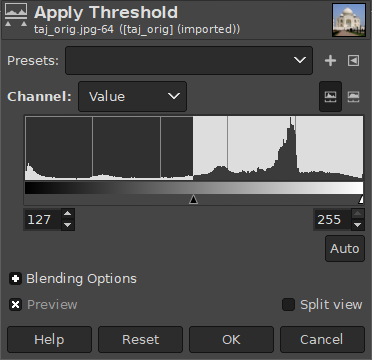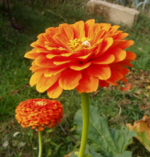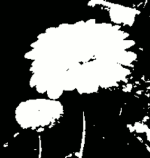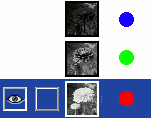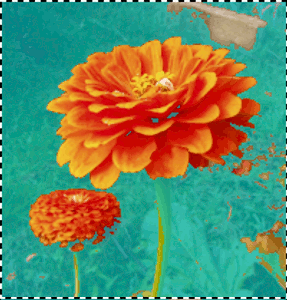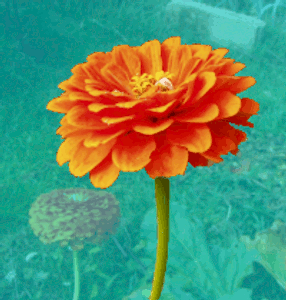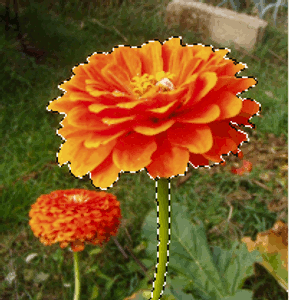The Threshold filter transforms the current layer or the selection into a black and white image, where white pixels represent the pixels of the image where the value for the chosen Channel is in the threshold range, and black pixels represent pixels with a value outside the threshold range.
È possibile usarlo per migliorare un'immagine in bianco e nero (ad esempio un testo scansionato) o per creare maschere di selezione.
![[Nota]](images/note.png)
|
Nota |
|---|---|
|
As this filter creates a black and white image, the anti-aliasing of the original image disappears. If this poses a problem, use the Levels tool instead. |
There are different possibilities to activate this:
-
This filter is found in the main menu under → ,
-
or by clicking the
icon in the Toolbox if Threshold has been enabled as a tool (which is disabled by default). For this, please refer to Sezione 6.13, «Strumenti».
- Preimpostazioni, Opzioni di fusione, Anteprima, Merge filter, Dividi vista
-
![[Nota]](images/note.png)
Nota These options are described in Sezione 8.1.2, «Caratteristiche comuni dei colori».
- Canale
-
This allows you to select which channel(s) will be used to apply the Threshold. The default is Value, which will use all color channels, but you can also choose to use a single channel: Red, Green, Blue and Alpha (only available when the layer has an alpha channel), Luminance, or RGB.
-
Istogramma lineare,
Istogramma logaritmico
-
These two buttons to the right of the Channel selection let you choose the type of histogram shown.
- Campo della soglia
-
The Threshold tool provides a visual graph, a histogram, of the intensity value of the active layer or selection. You can set the threshold range either using the minimum and maximum input boxes, or by clicking and dragging on the graph. It allows you to select a part of the image with some intensity from a background with another intensity. Pixels inside the range are white, and the others are black. Adjust the range to get the selection you want in white on black background. The button can be used to automatically adjust the threshold.
Sometimes an element you want to extract from an image can stand out well against the background. In this case, you can use the Threshold tool to select this element as a whole, and then use a Quick mask.
-
First start decomposing your image into its RGB and HSV components by using the Decompose filter. A new grayscale image is created and the components are displayed as layers in the Layers Dialog. These layers come with a thumbnail but it is too small for an easy study. You can, of course, increase the size of this preview with the dialog menu (the small triangular button), but playing with the «eyes» is more simple to display the wanted layer in the decompose image. Select the layer that isolates the element the best.
-
Chiama lo strumento Soglia dall'immagine scomposta. Spostando il cursore nero, adatta la soglia per isolare al meglio l'elemento che si desidera estrarre. Quest'ultimo probabilmente non sarà perfetto: si migliorerà il risultato con la maschera di selezione che andremo a creare.
![[Avvertimento]](images/warning.png)
Avvertimento Assicurarsi di aver selezionato il livello giusto quando si richiama lo strumento Soglia: quando è aperto, non è possibile passare ad un altro livello.
Figura 16.220. Il livello selezionato dopo la regolazione della soglia
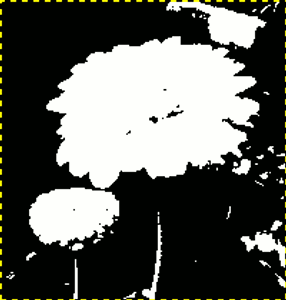
Ecco il miglior contorno per il nostro fiore. Ci sono diversi oggetti rossi che sono da rimuovere.
-
Assicurarsi che l'immagine che mostra il livello selezionato sia attiva e copiarla negli appunti con Ctrl+C.
-
Now, make the original image active. Click the button at the bottom-left corner of the image window: the image gets covered with a red (default) translucent mask. This red color does not suit well to our image with much red: go to the Channels dialog, activate the «Quick mask» channel and change this color with the . Come back to the original image. Press Ctrl+V to paste the previously copied layer.
-
Voilà. Your selection mask is ready: you can improve the selection as usual. When the selection is ready, disable the Quick mask by clicking its button again: you will see the marching ants around the selection.
We used the Zoom to work at a pixel level, Free Select to remove large unwanted areas, the pencil (to get hard limits), black paint to remove selected areas, white paint to add selected areas, especially for stem.
